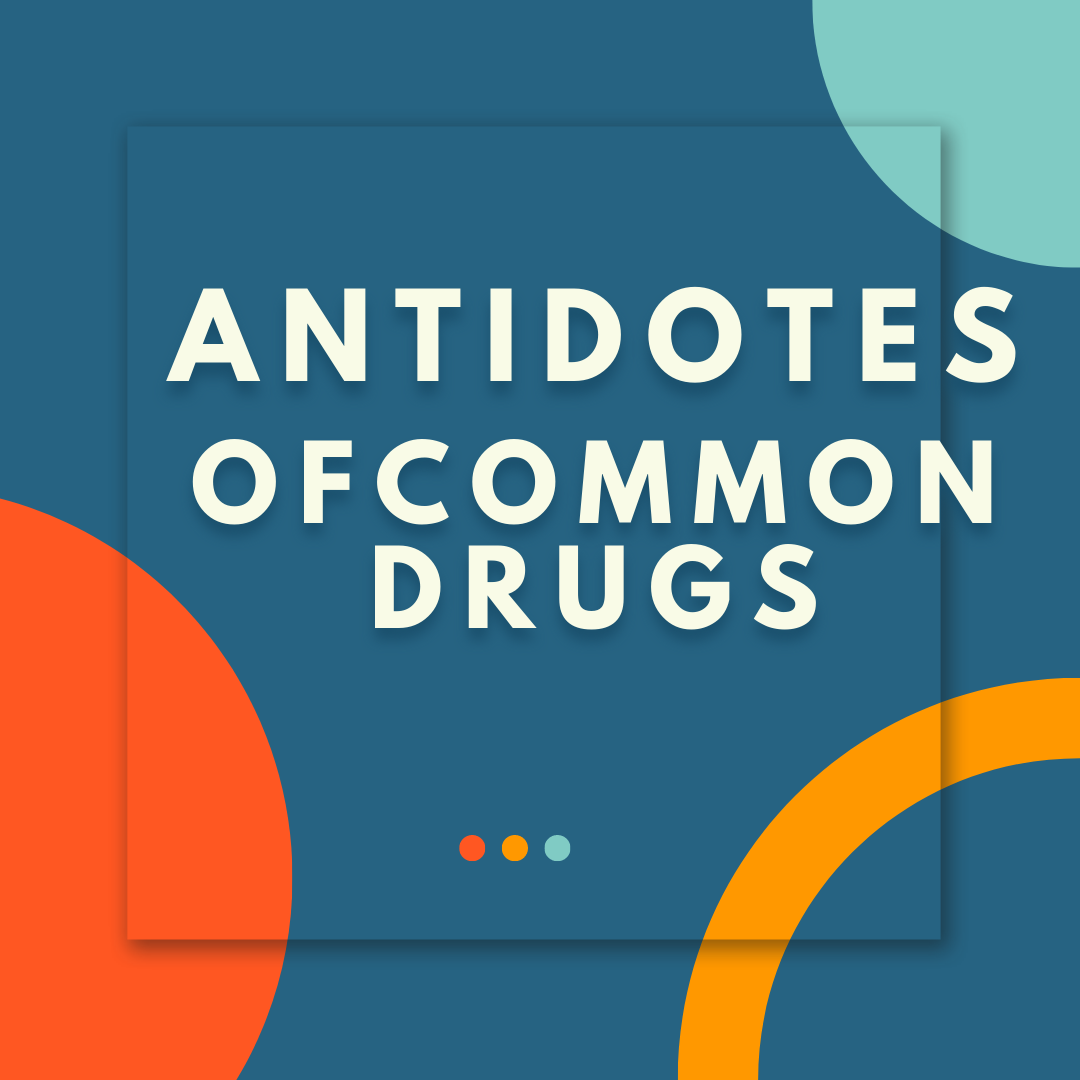The term antidote is a GREEK word which means “given against“.
For passing the NCLEX, you must know the antidotes of the common drugs. In this post, I will mention all the common antidotes which is necessary for the nurses to know which are most commonly used in the hospital setting.
Before listing antidotes, I would love to explain what exactly antidotes are. Why it is necessary for the nurse to know about the antidotes?
Antidotes are drug, chelating substance, or a chemical that counteracts the effects of another drug or a poison.
Antidotes are the substances that we can give to work against some toxicities or overdose or poisoning that is occurring in the body.
Whenever you are working as a nurse it’s always important like if you are going to be giving some heparin, warfarin or digoxin, you want to know in the back of your mind okay what is that antidote in case my patient experiences “TOXICITY” because you want to be able to go and grab that fast.
- DIGOXIN
- If patient can have digoxin toxicity (this is a cardiac glycoside), what can give to help reverse those effects. Well, it’s really easy to remember it’s called DIGIBINDS so whenever you give Digi binds, they will reverse the effects.
- HEPARIN
- Heparin is an ANTICOAGULANT so it’s a blood thinner.
- Now it’s a fine balance between having patient’s blood too thin or too thick but if they are having heparin like toxicity where they have too much on board, we can give the antidote PROTAMINE SULFATE. and that will help reverse those effects.
- WARFARIN:
- You may hear this referred to as Coumadin.
- This is also an anticoagulant so it thins the blood.
- An antidote for this is the VITAMIN K
- BENZODIAZEPINES:
- These are very strong SEDATIVE DRUGS that are highly addictive.
- A lot of their medication names end in “pam” or “lam” such as Diazepam.
- That’s VALIUM
- So if a patient takes too much of this they can have adverse effects we can give antidote for it.
- The name of the antidote for that toxicity is FLUMAZENIL.
- OPIOIDS:
- Just like benzos, are highly addictive.
- They are PAINKILLERs.
- We are talking about drugs like MORPHINE, FENTANYL, etc.
- We can give what’s call NALOXONE for an antidote.
- You probably heard a lot about the opioids issues that we have in the U.S. and NARCAN (NALOXONE) is used to reverse the effects of the opioids.
- ACETAMINOPHEN:
- In U.S. that is TYLENOL
- This is like a painkiller you can take over the counter
- So, if patient takes too much of this say they are trying to commit suicide overdose they we can give them what’s called ACETYLCYSTEINE.
- How I remember this antidote is that ACETYLCYSTEINE has ACE in it and so does Acetaminophen so those two go together and that helps me remember that.
- BETA-BLOCKERS:
- These are CARDIAC medications.
- They end in “lol” like METOPROLOL, ATENOLOL, etc.
- If a patient gets too much of that on board toxicity with that, we can give them GLUCAGON
- How you remember that is that with beta blockers remember they mask hypoglycemia so GLUCAGON like glucose that’s how you keep those two straight.
- ANTICHOLINERGIC TOXICITY along with CHOLINERGIC TOXICITY, these two conditions are opposite of each other.
- ANTICHOLINERGIC TOXICITY:
- This can be caused by various medications that really affect those receptor sites and cause anti-cholinergic effects, but we have too much occurring in the body, so we are writing about a lot of medications like ANTIHISTAMINES or ATROPINE, etc.
- If toxicity happens, we give what’s called PHYSOSTIGMINE (antidote).
- On the flip side, we have CHOLINERGIC TOXICITY:
- This can be caused by substances like ORGANOPHOSPHATES or CARBAMATES.
- These are substances that are typically found in INSECTICIDES, PESTICIDES and they can be used to POISON PEOPLE
- So, to help reverse that we can give ATROPINE.
- MAGNESIUM SULPHATE:
- Antidote for that is CALCIUM GLUCONATE.
- If you plan on working in OB, you will definitely remember that antidote for Magnesium Sulphate.
- CYANIDE POISONING:
- If patient has this, an antidote is HYDROOXOCOBALAMIN
- ETHYLENE GLYCOL or METHANOL
- Ethylene Glycol is found in antifreeze
- Methanol is found in like windshield wiper fluids so probably thinking how a person would get too much of this.
- Well, they could accidently ingest it or intentionally ingest it like trying to commit suicide or maybe they were poison like ethylene glycol with the antifreeze if you ever watched those like forensic shows there is a lot of cases where the person’s being poisoned with antifreeze with this ethylene glycol.
- So, antidotes for these are FOMEPIZOLE.
- LEAD TOXICITY
- Too much lead in the body.
- We can do what’s called CHELATION therapy and this is a method where we remove those heavy metals from the bloodstream
- SUCCIMER (Oral chelation medication) / CALCIUM EDTA (via injection)
- IRON TOXICITY
- DEFEROXAMINE
| COMMON DRUGS | ANTIDOTES |
| DIGOXIN | DIGIBIND or DIGIFAB (immune fab) |
| HEPARIN | PROTAMINE |
| WARFARIN (coumadin) | VITAMIN-K |
| BENZODIAZIPINES | FLUMAZENIL |
| OPIOIDS | NALOXONE (NARCAN) |
| ACETAMINOPHEN (TYLENOL) | ACETYLCYSTEINE |
| BETA-BLOCKERS | GLUCAGON |
| ANTICHOLINERGIC TOXICITY | PHYSOSTIGMINE |
| CHOLINERGIC TOXICITY | ATROPINE |
| MAGNESIUM SULPHATE | CALCIUM GLUCONATE |
| CYANIDE POISONING | HYDROXOCOBALAMIN |
| ETHYLENE GLYCOL or METHANOL | FOMEPIZOLE |
| LEAD TOXICITY | SUCCIMER or CALCIUM EDTA |
| IRON TOXICITY | DEFEROXAMINE |

